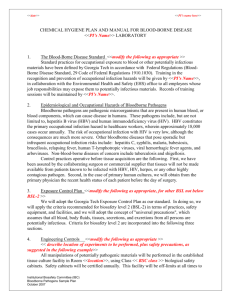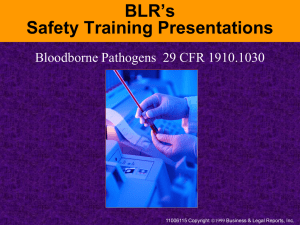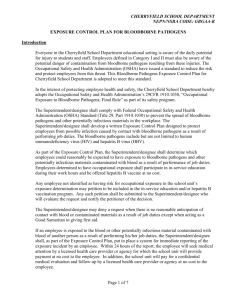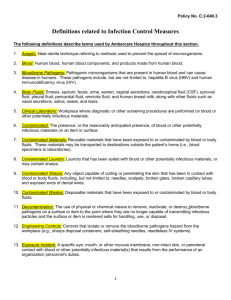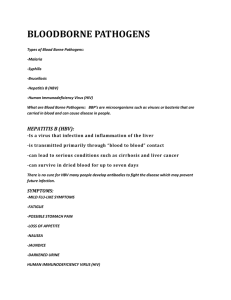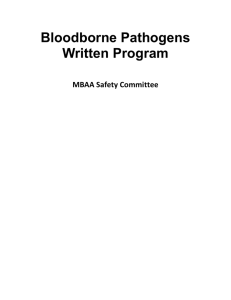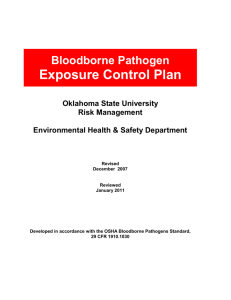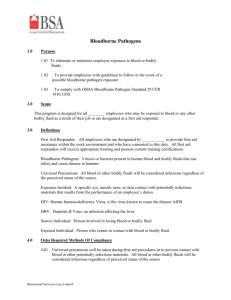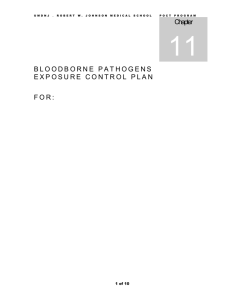Operating Policies for Controlling Exposure to Bloodborne Pathogens
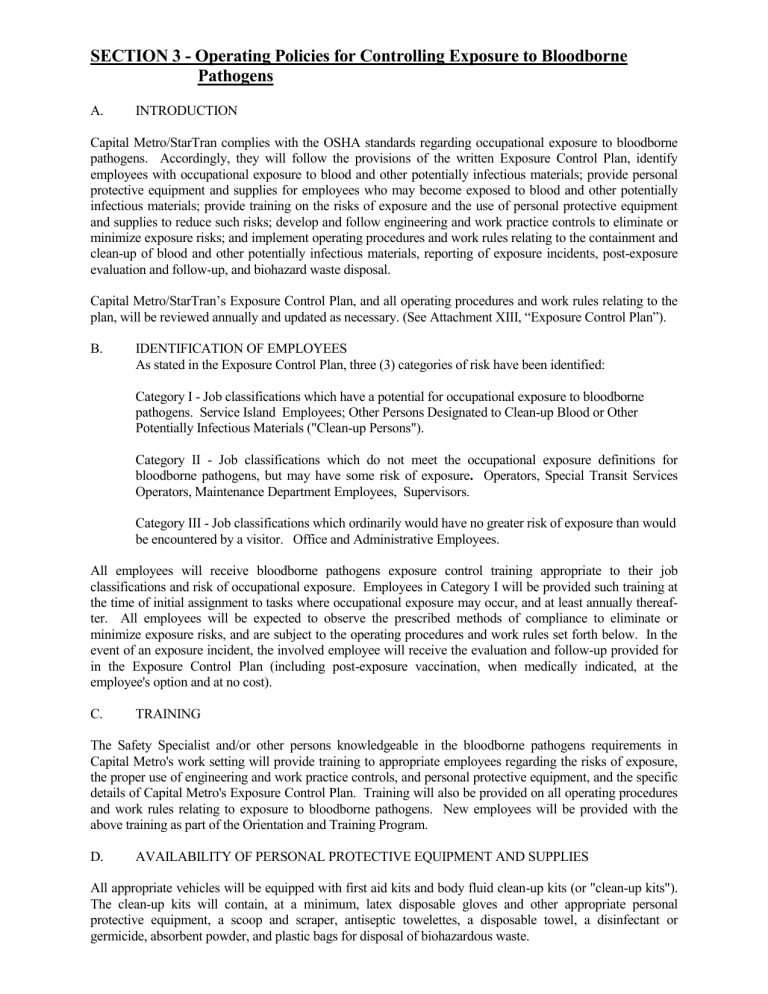
SECTION 3 - Operating Policies for Controlling Exposure to Bloodborne
Pathogens
A. INTRODUCTION
Capital Metro/StarTran complies with the OSHA standards regarding occupational exposure to bloodborne pathogens. Accordingly, they will follow the provisions of the written Exposure Control Plan, identify employees with occupational exposure to blood and other potentially infectious materials; provide personal protective equipment and supplies for employees who may become exposed to blood and other potentially infectious materials; provide training on the risks of exposure and the use of personal protective equipment and supplies to reduce such risks; develop and follow engineering and work practice controls to eliminate or
B. minimize exposure risks; and implement operating procedures and work rules relating to the containment and clean-up of blood and other potentially infectious materials, reporting of exposure incidents, post-exposure evaluation and follow-up, and biohazard waste disposal.
Capital Metro/StarTran’s Exposure Control Plan, and all operating procedures and work rules relating to the plan, will be reviewed annually and updated as necessary. (See Attachment XIII, “Exposure Control Plan”).
IDENTIFICATION OF EMPLOYEES
As stated in the Exposure Control Plan, three (3) categories of risk have been identified:
Category I - Job classifications which have a potential for occupational exposure to bloodborne pathogens. Service Island Employees; Other Persons Designated to Clean-up Blood or Other
Potentially Infectious Materials ("Clean-up Persons").
Category II - Job classifications which do not meet the occupational exposure definitions for bloodborne pathogens, but may have some risk of exposure . Operators, Special Transit Services
Operators, Maintenance Department Employees, Supervisors.
Category III - Job classifications which ordinarily would have no greater risk of exposure than would be encountered by a visitor. Office and Administrative Employees.
All employees will receive bloodborne pathogens exposure control training appropriate to their job classifications and risk of occupational exposure. Employees in Category I will be provided such training at the time of initial assignment to tasks where occupational exposure may occur, and at least annually thereafter. All employees will be expected to observe the prescribed methods of compliance to eliminate or minimize exposure risks, and are subject to the operating procedures and work rules set forth below. In the event of an exposure incident, the involved employee will receive the evaluation and follow-up provided for in the Exposure Control Plan (including post-exposure vaccination, when medically indicated, at the employee's option and at no cost).
C. TRAINING
The Safety Specialist and/or other persons knowledgeable in the bloodborne pathogens requirements in
Capital Metro's work setting will provide training to appropriate employees regarding the risks of exposure, the proper use of engineering and work practice controls, and personal protective equipment, and the specific details of Capital Metro's Exposure Control Plan. Training will also be provided on all operating procedures and work rules relating to exposure to bloodborne pathogens. New employees will be provided with the above training as part of the Orientation and Training Program.
D. AVAILABILITY OF PERSONAL PROTECTIVE EQUIPMENT AND SUPPLIES
All appropriate vehicles will be equipped with first aid kits and body fluid clean-up kits (or "clean-up kits").
The clean-up kits will contain, at a minimum, latex disposable gloves and other appropriate personal protective equipment, a scoop and scraper, antiseptic towelettes, a disposable towel, a disinfectant or germicide, absorbent powder, and plastic bags for disposal of biohazardous waste.
First aid kits and clean-up kits will also be available at the Maintenance Facility, and driver’s ready room.
Additional cleaning supplies for handling spills of blood and other potentially infectious materials will be kept in the Maintenance facility.
Whenever any of the supplies contained in a first aid kit or a clean-up kit are used by an employee (or other person), this must be immediately reported to the On Duty Supervisor, or the Manager or Supervisor in charge of the employee's department (in cases involving employees), and noted in a written incident report.
E. REPORTING PROCEDURES
Any work-related incident involving exposure or potential exposure to blood or other potentially infectious materials (including all human body fluids that may or may not be visibly contaminated with blood) must be immediately reported to the On Duty Supervisor, or the Manager or Supervisor in charge of the employee's department (in cases involving non-transportation employees).
A written incident report must be submitted to the Safety Specialist, or her/his designee, within twenty-four
(24) hours unless otherwise directed by management following any incident of exposure or potential exposure to blood or other potentially infectious materials. The employee must fully complete the report form and provide all requested information, including a list of any equipment or supplies used in connection with the incident. The employee should check with the Safety Specialist or the Manager or Supervisor in charge of the employee's Department (if the Safety Specialist is not available) for instructions on when the written incident report must be submitted. In some cases, a preliminary report may be required immediately.
F. METHODS OF COMPLIANCE TO MINIMIZE EXPOSURE RISKS
Employees must observe the prescribed methods of compliance to minimize the risk of exposure to blood or other potentially infectious materials, as set forth in Capital Metro's Exposure Control Plan and any additional operating procedures issued by the Safety Specialist. These methods of compliance include, but are not limited to, the following:
1. Observation of universal precautions to prevent contact with blood or other potentially infectious materials. According to the concept of universal precautions, all blood and certain human body fluids shall be treated as if known to be infectious for HIV, Hepatitis B virus (HBV) and other pathogens.
2. Use of engineering and work practice controls designed to eliminate or minimize the risk of exposure. This includes use of devices, tools and equipment to isolate or remove the bloodborne pathogens hazard, and reducing the likelihood of exposure by altering the manner in which tasks are performed.
3. Wash hands immediately after removal of gloves or other personal protective equipment. Wash hands or any other skin, and flush mucous membranes with water, immediately following contact of such body areas with blood or other potentially infectious materials.
4. Having employees avoid touching their eyes and lips if they have had possible contact with contaminated surfaces or fluids.
5. Prohibit eating, drinking, smoking, applying cosmetics or lip balm, and handling contact lenses whenever any condition exists that creates a reasonable likelihood of occupational exposure.
6. Use of personal protective equipment that does not permit blood or other potentially infectious material to reach the employee's work clothes or skin whenever there is a risk or potential risk of an exposure incident.
7. Gloves must be worn whenever it is reasonably anticipated that the employee may have contact with blood, other potentially infectious materials, mucous membranes, non-intact skin, or contaminated items or surfaces.
8. Removal and proper disposal of garments penetrated by blood or other potentially infectious materials immediately. Removal and proper disposal of all personal protective equipment following use and prior to leaving any work area.
9. All potentially infectious materials will be cleaned up and disposed of in accordance with OSHA standards.
10. Safety violations may be reported to the Industrial Safety Specialist or the Texas
Department of Health.
